
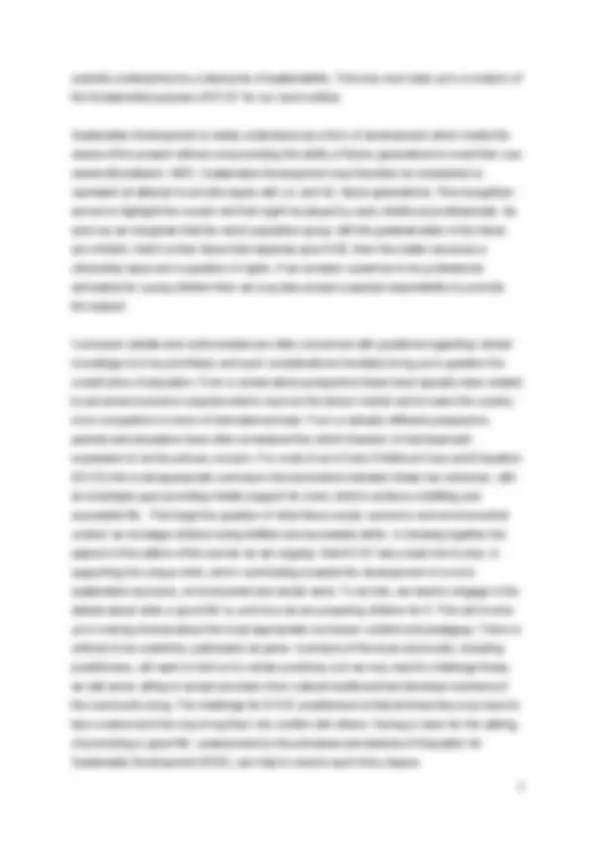
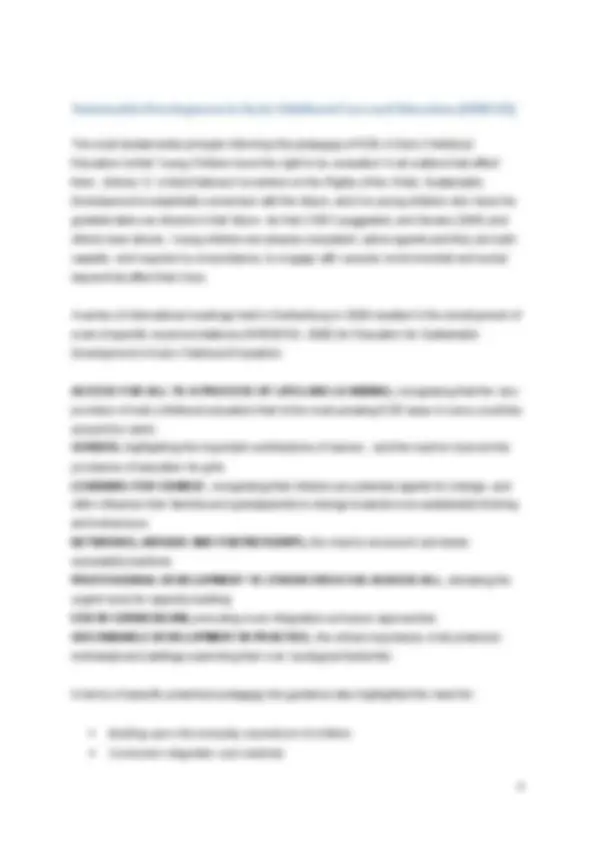
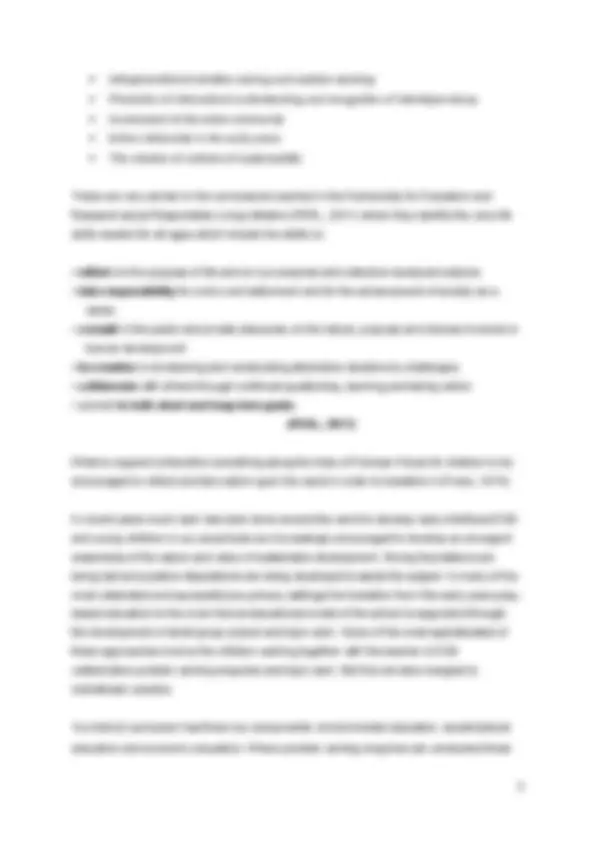
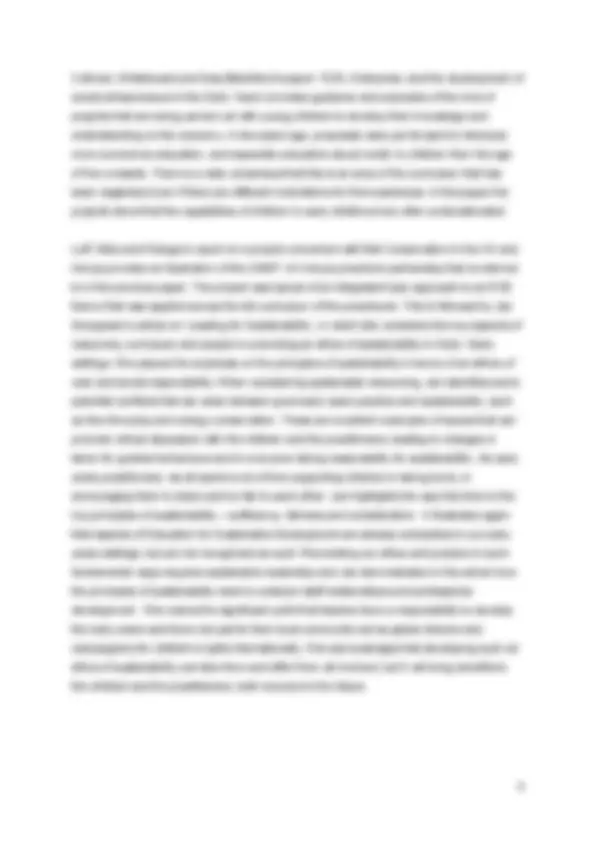
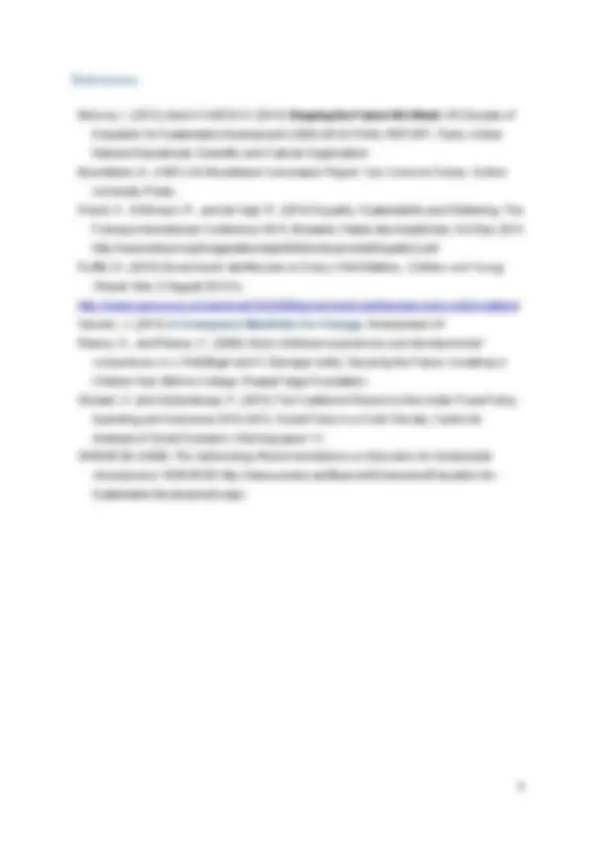
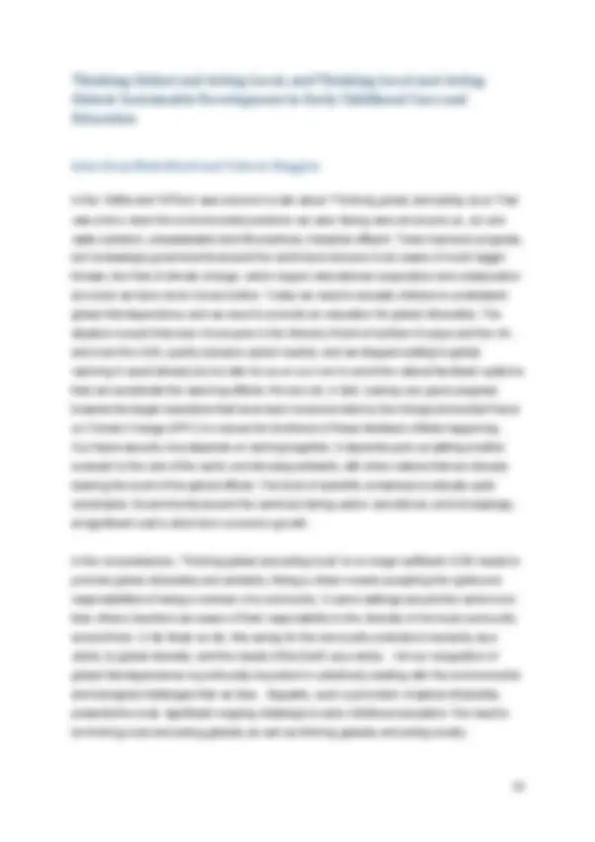
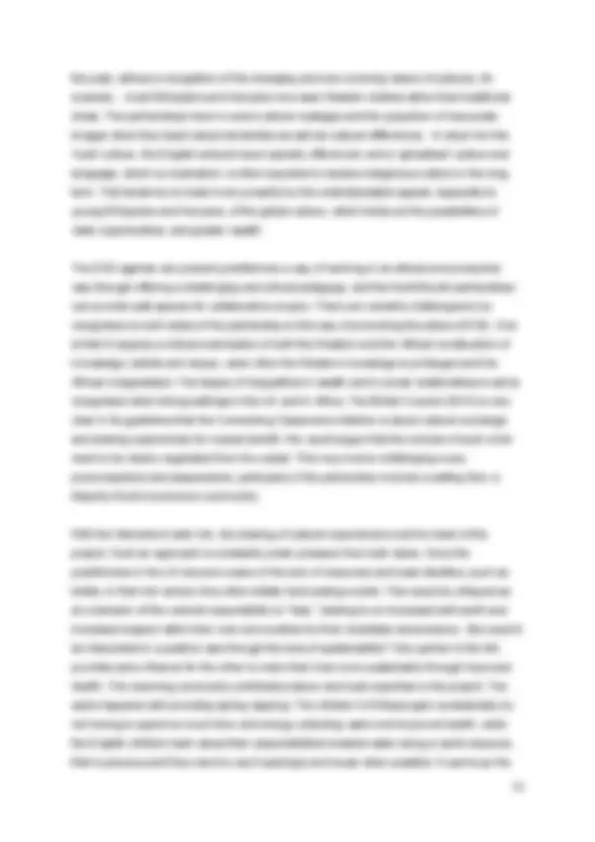
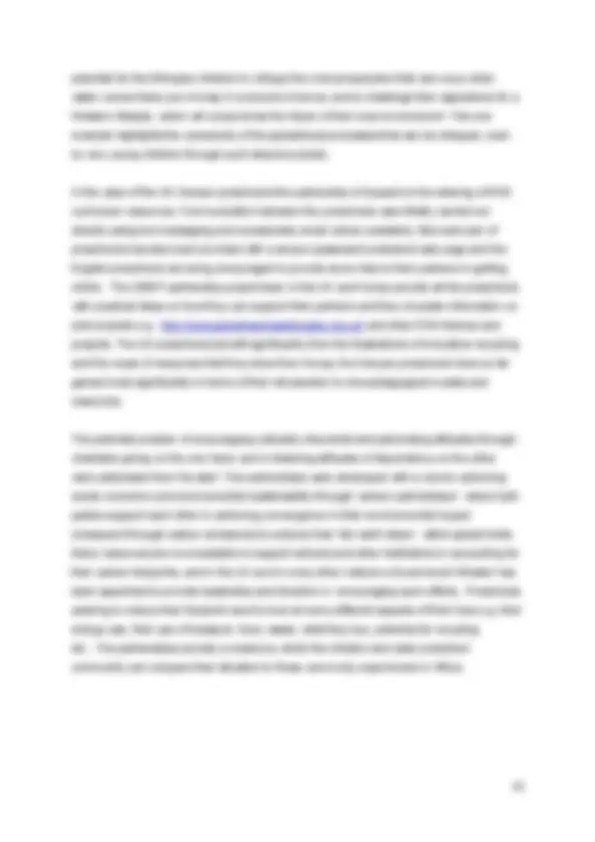
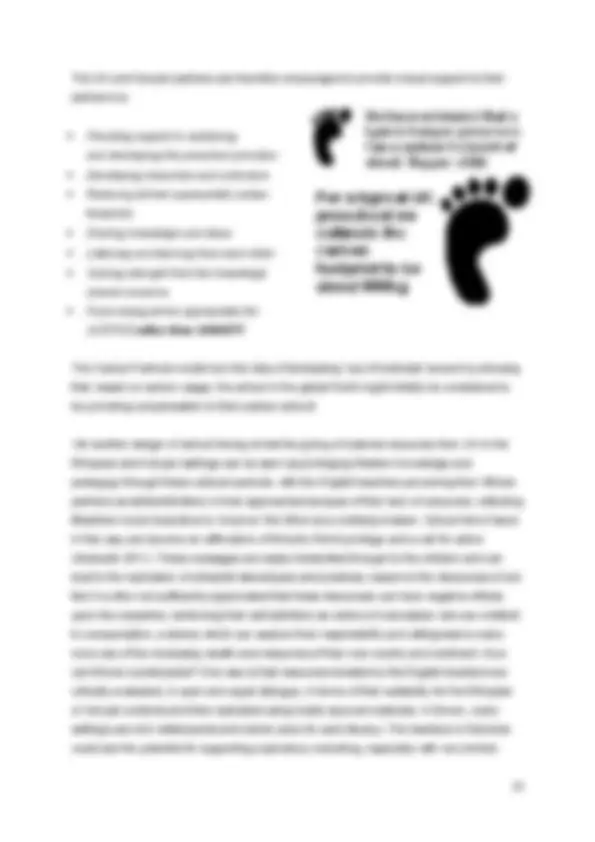
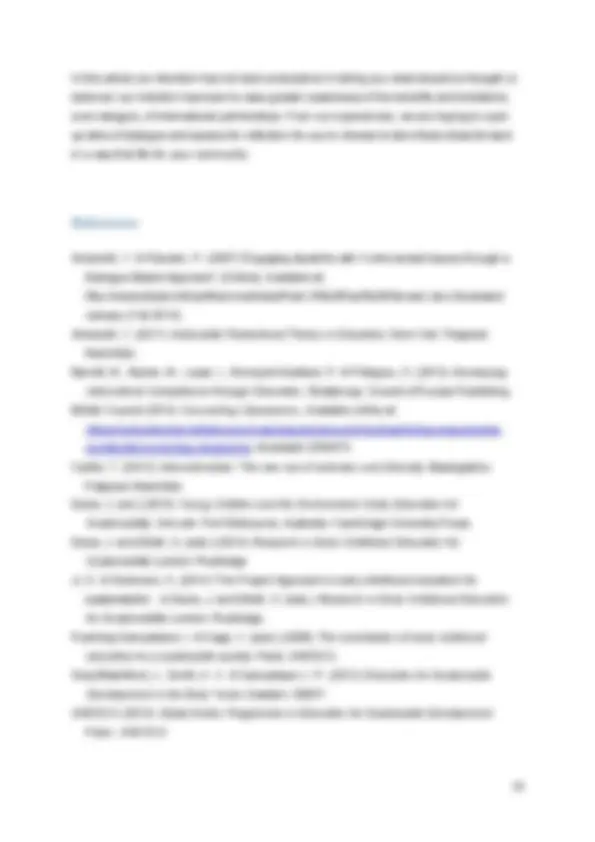
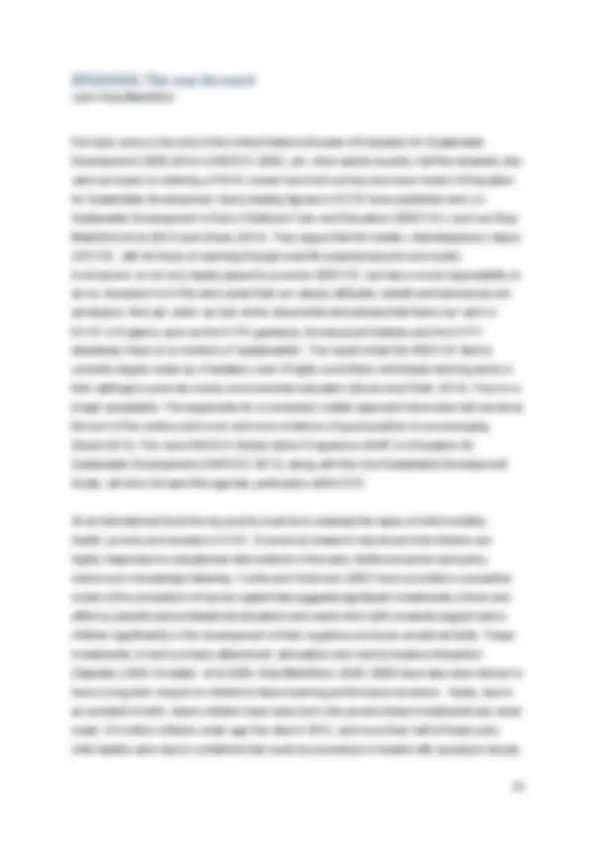
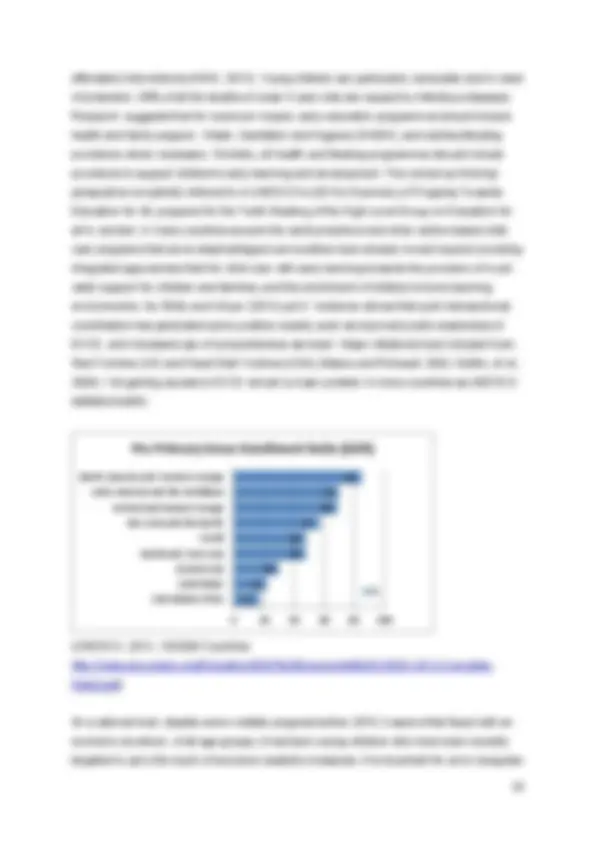
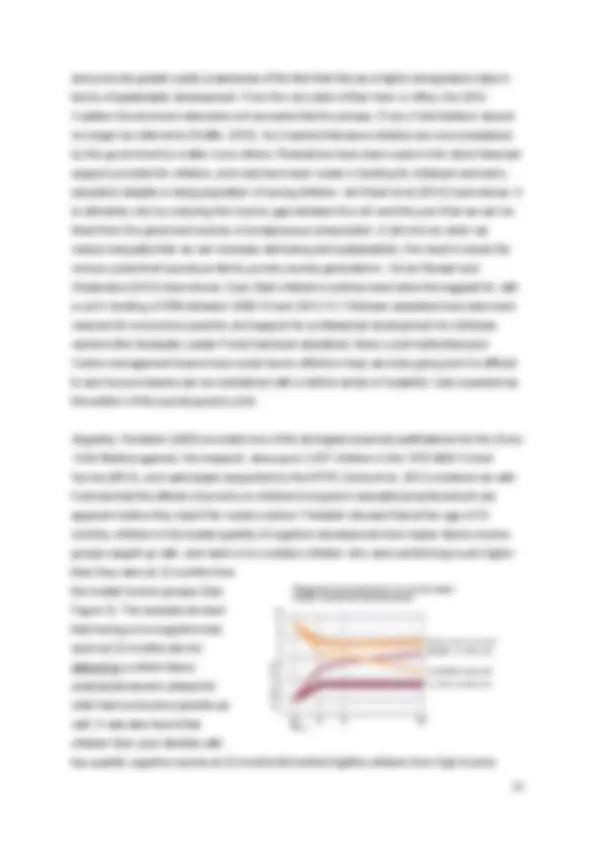
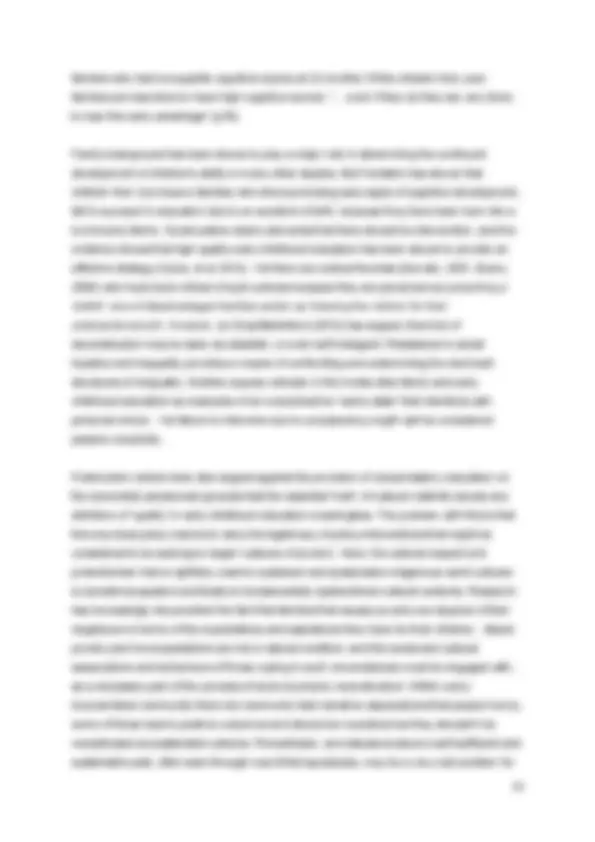
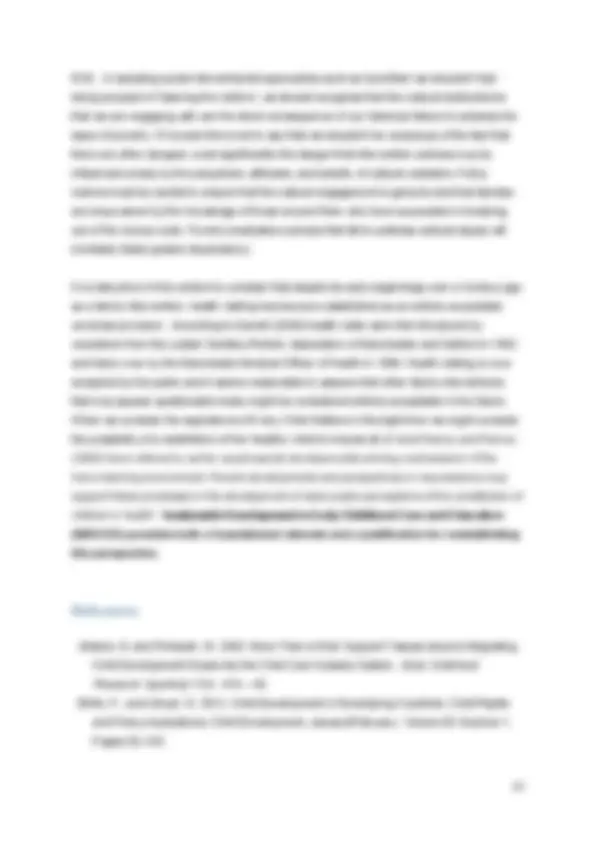
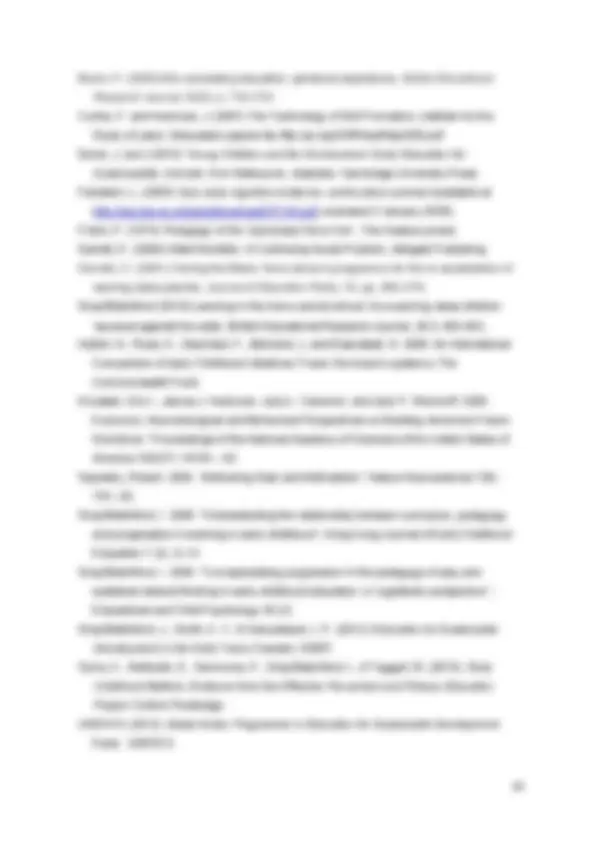


Study with the several resources on Docsity

Earn points by helping other students or get them with a premium plan


Prepare for your exams
Study with the several resources on Docsity

Earn points to download
Earn points by helping other students or get them with a premium plan
Community
Ask the community for help and clear up your study doubts
Discover the best universities in your country according to Docsity users
Free resources
Download our free guides on studying techniques, anxiety management strategies, and thesis advice from Docsity tutors
A special edition of the Early Education Journal focused on Education for Sustainable Development (ESD) in Early Childhood Care and Education (ECCE). The editorial by Siraj-Blatchford and Huggins discusses the importance of promoting ESD in ECCE and the role young children play in shaping their future. The edition includes articles on various aspects of ESD in ECCE, such as pedagogy, enterprise, and conservation projects.
Typology: Study notes
1 / 24

This page cannot be seen from the preview
Don't miss anything!

















John Siraj-Blatchford and Valerie Huggins
Alice Warwick and Paul Warwick
John Siraj-Blatchford and Valerie Huggins
Penny Coltman, David Whitebread and John Siraj-Blatchford
Paulette Luff, Zoe Miles and Cicilia Wangui
Jan Georgeson EPILOGUE: The way forward John Siraj-Blatchford and Valerie Huggins
UN Secretary General Ban Ki-moon has suggested that 2015 may be the most important year since the founding of the UN seventy years ago. The third UN Conference on Financing for Development will be convened in Addis Ababa in July, the UN Summit on Sustainable Development in New York in September, where the UN Sustainable Development Goals (SDGs), that are set to replace and build on the achievement of the Millennium Development Goals (MDGs), will be agreed, and then there is the UN Climate Change Conference in Paris in December. A reorientation of international efforts is taking place to address the common challenges to sustainability that are being caused by environmental degradation and climate change, biodiversity loss, the disruption and insecurities caused by natural disasters, conflict, and deep economic and social inequalities. Nicholas Stern, a Former World bank chief economist and UK government economic advisor, has described Climate Change as the ‘greatest market failure in history’, and he has estimated that in the absence of radical intervention, it could reduce global GDP by 20% by 2050 (cited in Sauven, 2015). Education for Sustainable Development is seen as fundamentally important in addressing these problems. As Irina Bokova, Director-General of UNESCO has argued: “Education is the most powerful path to sustainability. Economic and technological solutions, political regulations or financial incentives are not enough. We need a fundamental change in the way we think and act (Bokova, 2012)” Early Childhood Education has been recognised as a significant contributor to ESD (UNESCO, 2014). It is in the early years that many fundamental attitudes towards the environment, towards consumption and waste, and towards fairness and social justice are formed. Yet as we have come to the end of the UN Decade for Sustainable Development (2005-2014), and the MDGs (2000-2015), it is timely to reflect on how ESD has been promoted in ECCE settings in the UK, and what might be the priorities for future development. It provides an opportunity to rethink some of our existing taken-for-granted practices, to consider them in light of our increasingly diverse communities and make them
The most fundamental principle informing the pedagogy of ESD in Early Childhood Education is that Young Children have the right to be consulted ‘in all matters that affect’ them (Article 12 United Nations Convention on the Rights of the Child). Sustainable Development is essentially concerned with the future, and it is young children who have the greatest stake as citizens in that future. As Hart (1997) suggested, and Davies (2005) and others have shown, Young children are already competent, active agents and they are both capable, and required by circumstance, to engage with complex environmental and social issues that affect their lives. A series of international meetings held in Gothenburg in 2008 resulted in the development of a set of specific recommendations (SWEDESD, 2008) for Education for Sustainable Development in Early Childhood Education: ACCESS FOR ALL TO A PROCESS OF LIFELONG LEARNING, recognising that the very provision of early childhood education that is the most pressing ESD issue in many countries around the world. GENDER, highlighting the important contributions of women, and the need to improve the provisions of education for girls. LEARNING FOR CHANGE , recognising that children are potential agents for change, and often influence their families and grandparents to change towards more sustainable thinking and behaviours NETWORKS, ARENAS AND PARTNERSHIPS, the need to document and share successful practices. PROFESSIONAL DEVELOPMENT TO STRENGTHEN ESD ACROSS ALL , stressing the urgent need for capacity building ESD IN CURRICULUM, promoting more integrated curriculum approaches. SUSTAINABLE DEVELOPMENT IN PRACTICE, the critical importance of all preschool individuals and settings examining their own ‘ecological footprints’. In terms of specific preschool pedagogy the guidance also highlighted the need for:
equipment or shopping around for best price for the ingredients for cake-making are good examples. Alongside this is needed an explicit ethos of thrift, the constant challenging of over-consumption and waste, commenting on value for money, resistance to advertising and peer pressure, e.g. present buying for birthdays and special occasions, and encouraging the children to come to the setting dressed in working clothes rather than their best, to avoid unnecessary damage and unnecessary expenditure. Many of these themes are taken up in the papers included in this edition of the journal. In their ‘Pedagogy of Love’ article, Alice and Paul Warwick draw on their considerable expertise in Early Years Education and Education for Sustainable Development (ESD) to advocate a pedagogy of hope for young children. They argue powerfully that early years practitioners have a leading role in equipping children to live sustainable and caring lives, both in the present and in their futures. Using a six-dimensional butterfly model, Alice and Paul identify the centrality of values in ESD, such as care and compassion towards each other and the planet. They link this to the Early Years Foundation Stage framework, demonstrating that ESD is not an addition to our current provision, but a reorientation of what we currently do well in our settings. Alice and Paul suggest a playful approach to SDECCE, underpinned by optimistic and appreciative activities, that encourage us to tackle what may be potentially difficult and depressing sustainability topics, such as climate change and biodiversity loss, in a way that builds on children’s natural curiosity and sense of wonder of their world, and gives them ways to make a positive difference. They provide practical examples and a case study of a school to illustrate this approach and show us how to reorientate our pedagogy to place ECE for Sustainable Development at the heart of what we do. In our ‘Thinking global and acting local, and thinking local and acting global: Sustainable Development in Early Childhood Care and Education’ paper, we identify the value and importance, of entering into international school links and partnerships, as well as potential pitfalls and dangers. We argue that the development of global citizenship and solidarity has become a priority in supporting SDECCE.
Coltman, Whitebread and Siraj-Blatchford’s paper: ‘ESD, Enterprise, and the development of social entrepreneurs in the Early Years’ provides guidance and examples of the kind of projects that are being carried out with young children to develop their knowledge and understanding on the economy. A few years ago, proposals were put forward to introduce more economics education, and especially education about credit, to children from the age of five onwards. There is a wide consensus that this is an area of the curriculum that has been neglected even if there are different motivations for this awareness. In this paper the projects show that the capabilities of children in early childhood are often underestimated. Luff, Miles and Wangui’s report on a project concerned with Bat Conservation in the UK and Kenya provides an illustration of the OMEP UK-Kenya preschool partnership that is referred to in the previous paper. The project was typical of an integrated topic approach to an ESD theme that was applied across the full curriculum of the preschools. This is followed by Jan Georgeson’s article on ‘Leading for Sustainability’, in which she considers the key aspects of resources, curriculum and people in promoting an ethos of sustainability in Early Years settings. She places the emphasis on the principles of sustainability in terms of an ethics of care and social responsibility. When considering sustainable resourcing, Jan identifies some potential conflicts that can arise between good early years practice and sustainability, such as free-flow play and energy conservation. These are excellent examples of issues that can promote critical discussion with the children and the practitioners, leading to changes in taken for granted behaviours and in everyone taking reasonability for sustainability. As early years practitioners, we all spend a lot of time supporting children in taking turns, in encouraging them to share and be fair to each other. Jan highlights the way this links to the key principles of sustainability – sufficiency, fairness and consideration. It illustrates again that aspects of Education for Sustainable Development are already embedded in our early years settings, but are not recognized as such. Reorienting our ethos and practice in such fundamental ways requires sustainable leadership and Jan demonstrates in this article how the principles of sustainability need to underpin staff relationships and professional development. She makes the significant point that leaders have a responsibility to develop the early years workforce not just for their local community but as global citizens and campaigners for children’s rights internationally. She acknowledges that developing such an ethos of sustainability can take time and effort from all involved, but it will bring benefits to the children and the practitioners, both now and in the future.
In the 1960s and 1970s it was common to talk about "Thinking global , and acting local. That was a time when the environmental problems we were facing were all around us...air and water pollution, unsustainable land fill practices, industrial effluent. There has been progress, but increasingly governments around the world have become more aware of much bigger threats, like that of climate change, which require international cooperation and collaboration at a level we have never known before. Today we need to educate children to understand global interdependency and we need to promote an education for global citizenship. The situation is such that even if everyone in the Minority World of northern Europe and the UK, and even the USA, quickly became carbon neutral, and we stopped adding to global warming it would already be too late for us on our own to avoid the natural feedback systems that can accelerate the warming effects. We are not, in fact, making very good progress towards the target reductions that have been recommended by the Intergovernmental Panel on Climate Change (IPPC) to reduce the likelihood of these feedback effects happening. Our future security now depends on working together, it depends upon us setting a better example to the rest of the world, and showing solidarity with other nations that are already bearing the brunt of the global effects. The level of scientific consensus is actually quite remarkable. Governments around the world are taking action, sometimes, and increasingly, at significant cost to short term economic growth. In the circumstances, “Thinking global and acting local” is no longer sufficient, ESD needs to promote global citizenship and solidarity. Being a citizen means accepting the rights and responsibilities of being a member of a community. In some settings around the world more than others, teachers are aware of their responsibility to the diversity in the local community around them. In far fewer so far, this caring for the community extends to humanity as a whole, to global diversity, and the needs of the Earth as a whole. Yet our recognition of global interdependence is profoundly important in collectively dealing with the environmental and biological challenges that we face. Arguably, such a promotion of global citizenship presents the most significant ongoing challenge to early childhood education. We need to be thinking local and acting globally as well as thinking globally and acting locally.
One way that we have been trying to achieve this in practice has been in creating learning partnerships between children, students and practitioners in the UK and in sub-saharan Africa. Some of these are part of the British Council ‘Connecting Classrooms’ initiative (British Council 2014) and some are supported by OMEP, but either way, we have learnt that there are significant challenges for all involved. One example of this work has been the Exeter Ethiopia Link in Devon which supports up to 20 school links with settings in Nekemte in Ethiopia. Originally involving mainly primary children, the introduction of O grade schooling for children aged 4-6 in Ethiopia is now giving the schools involved a focus on Early Education. Another project has been the World Organisation for Early Childhood (OMEP) partnership between a similar number of preschools in East Dorset and in Kenya. One of the most significant difficulties with such initiatives has often been that there have been unchallenged assumptions made that they will be of benefit for everyone involved, a taken-for-granted notion that they are a good thing, based on notions of cultural supremacy from the UK participants, and an opportunity for obtaining money and material resources from the Ethiopian and Kenyan perspective. There are clearly different concerns about sustainability in the two communities. In the Majority World context of Ethiopia and Kenya, the focus of survival and sustainability is short-term, the emphasis is on access to basic education, health-care, nutrition and sanitation, while for us in the over-developed world it is on how to develop what we have without compromising further the needs of the children of the future. ‘Sustainability’ is an ever-evolving concept but issues of inequity apply in all communities. If you employ the sustainability lens/approach to curriculum in the same way, the communities in the two countries will learn different things, and thus ESD reveals the inadequacy of the conceptual construction of the Connecting Classrooms which seems to imply that both sides will learn and benefit in a similar way, simply learning about each other. A key voice in this debate, Vanesa Andreotti (2011:147) has argued that school links of this kind have the potential to: “‘provide an exciting and highly motivating opportunity to enable learners to engage ethically and productively with complex and interdependent processes that shape global/local contexts, identities and struggles for justice today and to build global solidarity.” But they have to be undertaken using a critical approach. Andreotti characterises this postcolonial perspective in terms of a debate that:
the past, without a recognition of the changing and ever-evolving nature of cultures, for example,. most Ethiopians and Kenyans now wear Western clothes rather than traditional dress. The partnerships have to avoid cultural nostalgia and the projection of inaccurate images when they teach about similarities as well as cultural differences. In return for this ‘local’ culture, the English schools have typically offered aid, and a ‘globalised’ culture and language, which by implication, is often expected to replace indigenous culture in the long term. This tendency is made more powerful by the understandable appeal, especially to young Ethiopians and Kenyans, of the global culture, which holds out the possibilities of wider opportunities, and greater wealth. The ESD agenda can present practitioners a way of working in an ethical and productive way through offering a challenging and critical pedagogy, and the North/South partnerships can provide safe spaces for collaborative enquiry. There are certainly challenges to be recognised on both sides of the partnership to this way of promoting the pillars of ESD. One is that it requires a critical examination of both the Western and the African construction of knowledge, beliefs and values, when often the Western knowledge is privileged and the African marginalised. The issues of inequalities in wealth and in power relationships must be recognised when linking settings in the UK and in Africa. The British Council (2014) is very clear in its guidelines that the Connecting Classrooms initiative is about cultural exchange and sharing experiences for mutual benefit. We would argue that the motives of such a link need to be clearly negotiated from the outset. This may involve challenging many preconceptions and assumptions, particularly if the partnership involves a setting from a Majority World low-income community. With the Nekemte-Exeter link, the sharing of cultural experiences is at the heart of the project. Such an approach is constantly under pressure from both sides. Once the practitioners in the UK become aware of the lack of resources and basic facilities, such as toilets, in their link school, they often initiate fund-raising events. This could be critiqued as an extension of the colonial responsibility to “help”, leading to an increased self-worth and increased respect within their own communities for their charitable benevolence. But could it be interpreted in a positive way through the lens of sustainability? One partner in the link provides some finance for the other to make their lives more sustainable through improved health. The receiving community contributes labour and local expertise to the project. The same happens with providing spring capping. The children in Ethiopia gain considerably by not having to spend so much time and energy collecting water and improved health, while the English children learn about their responsibilities towards water being a world resource, that is precious and they need to use it sparingly and reuse when possible. It opens up the
potential for the Ethiopian children to critique the overconsumption that can occur when water comes freely out of a tap in everyone’s homes, and to challenge their aspirations for a Western lifestyle, which will compromise the future of their local environment. This one example highlights the complexity of the global/local processes that can be critiqued, even by very young children through such shared projects. In the case of the UK-Kenyan preschools the partnership is focused on the sharing of ESD curriculum resources. Communication between the preschools was initially carried out directly using text messaging and occasionally email (where available). But each pair of preschools has also been provided with a secure (password protected) web page and the English preschools are being encouraged to provide some help to their partners in getting online. The OMEP partnership project team in the UK and Kenya provide all the preschools with practical ideas on how they can support their partners and they circulate information on joint projects e.g. http://www.globalhandwashingday.org.uk/ and other ESD themes and projects. The UK preschools benefit significantly from the illustrations of innovative recycling and the reuse of resources that they draw from Kenya, the Kenyan preschools have so far gained most significantly in terms of their introduction to new pedagogical models and resources. The potential problem of encouraging culturally chauvinist and patronising attitudes through charitable giving on the one hand, and in fostering attitudes of dependency on the other were addressed from the start. The partnerships were developed with a view to achieving social, economic and environmental sustainability through ‘carbon partnerships’ where both parties support each other in achieving convergence in their environmental impact (measured through carbon emissions) to achieve their ‘fair earth share’ within global limits. Many resources are now available to support schools and other institutions in accounting for their carbon footprints, and in the UK and in many other nations a Government Minister has been appointed to provide leadership and direction in encouraging such efforts. Preschools seeking to reduce their footprint need to look at many different aspects of their lives e.g. their energy use, their use of transport, food, waste, what they buy, potential for recycling etc. The partnerships provide a means by which the children and wider preschool community can compare their situation to those commonly experienced in Africa.
access to paper and pens. A local group of carpenters with disabilities was commissioned to make hundreds of mini-blackboards. This is now developing into a sustainable business as they are making a range of resources for mathematics too. This is sustainable and not reliant upon a continuous supply of donations. It seems clear that if such initiatives as Connecting Classrooms are to promote ESD they must involve stronger and more critical examination of current taken-for-grated approaches. The conceptual framework that we find useful to support this work is Andreotti’s critical literacy (Andreotti & Warwick 2007). Drawing on the work of Spivak, she puts forward a 4 stage model (Andreotti 2011). It starts with the fundamental process of learning to unlearn where we become aware of our own views and perspectives, of their dangers and limitations, recognising that they come from our own contexts. This allows a deeper recognition that although we are different from others in our own contexts, we share much in common. An example of this is a Journey to School Project carried out by the children in a school in Devon and one in Nekemte in Ethiopia. The children in each of the schools started the Project by sharing their experiences of their journey from home with each other in their own class, using a mix of photographs, drawings and talking. In Devon, the school was in a large village on the edge of a city. The children had quite short journeys, mostly by car as the parents dropped them off on their way into work, with some children walking accompanied by their parents. The partner school in Nekemte was in a rural area several kilometres from the town. All the children walked but the distances varied. They walked with the other children and very few were accompanied by their parents. The next stage, learning to listen , involved the children in making comparisons of experiences within their own community, considering the benefits and disadvantages of their choice of transport. Using the concept of carbon footprint the teachers encouraged the children to consider the environmental impact of their journey. The children then learned to learn from the perspectives of others through the exchange of letters, drawings and scribed photos on the topic of My Journey to School from the linked school. The teachers encouraged the children to consider the journeys through a sustainability lens and they then reconsidered their own experiences. Andreotti’s next step is being able to reach out and take this new understanding about the economic, environment and social impact of their journeys to consider other ways of behaving, and this may involve challenging the taken the granted ways of doing things. This can be tricky, when in England the families may have choices not open to those in Ethiopia,
such as using a car or walking, but the English children can consider their journey in terms of environmental friendliness and the impact of their families’ choices on people elsewhere in the world. Having undertaken this curriculum project, the children move on to another, with the Devon school and the Nekemte school taking in turns to identify the topic and engage in another cycle. As Andreotti (2011:230) notes “once one has learnt to reach out in one context, one is ready to start a new cycle of unlearning, listening, learning and reaching out again at another level.” Another aspect of the cycle is the interaction with the families of the children and this may lead to conflict, if the practitioners in the setting are challenging the actions and beliefs of the parents. Using a critical literacy approach to ESD will ensure that the children will be able to learn about different perspectives of complex global/local processes such as recycling and consider the implications of their own beliefs and actions. They will start to make responsible and conscious choices in the way they behave and start to form ethical and caring relationships with people in their own community and beyond (Andreotti 2011). The promotion of intercultural capabilities, such as empathy, curiosity and respect (Barrett, 2013), has to be central to the professional development of practitioners in order to counteract the dangers of linked projects and to ensure that they are beneficial to all. In our area, teacher education, we see the need to reorient our existing pedagogical approaches to ECE to explicitly include the 3 pillars of sustainability in all aspects of our work. We must underpin this with an ethos of interculturalism and the development of practitioners’ intercultural capabilities. In practice this means both embedding a culture of sustainability in our everyday routines and behaviours and offering opportunities for project- based work on sustainability topics that will provoke young children into critical discussion, problem solving and systemic thinking. To do the former, practitioners must adopt a whole-setting approach based on the principles of sustainability. Daily practices, such as recycling, saving energy and water, and giving them a voice in decision-making the setting, such as in circle time, will show young children that they can make a difference within the scope of their lives. For the latter, the project- based approach (Ji & Stumcke 2014), practitioners must consider specific activities that will for example provide intercultural encounters.
John Siraj-Blatchford We have come to the end of the United Nations Decade of Education for Sustainable Development (2005-2014) (UNESCO 2005), yet, when asked recently, half the students who were surveyed on entering a PGCE course have told us they had never heard of Education for Sustainable Development. Many leading figures in ECCE have published work on Sustainable Development in Early Childhood Care and Education (SDECCE), such as Siraj- Blatchford et al (2012) and Davis (2014). They argue that the holistic, interdisciplinary nature of ECCE, with its focus on learning through real-life experiences and community involvement, is not only ideally placed to promote SDECCE, but has a moral responsibility to do so, because it is in the early years that our values, attitudes, beliefs and behaviours are developed. And yet, when we look at the documents and policies that frame our work in ECCE in England, such as the EYFS guidance, Development Matters and the EYITT standards, there is no mention of ‘sustainability’. The result is that the SDECCE field is currently largely made up of isolated, even if highly committed, individuals working alone in their settings to promote mainly environmental education (Davis and Elliott, 2014). This is no longer acceptable. The arguments for a concerted, holistic approach have been set out since the turn of the century and more and more evidence of good practice is now emerging (Davis 2015). The new UNESCO Global Action Programme (GAP) in Education for Sustainable Development (UNESCO 2013), along with the new Sustainable Development Goals, will drive forward this agenda, particularly within ECE. At an international level the top priority must be to address the issue of child mortality, health, poverty and access to ECCE. Economics research has shown that children are highly responsive to educational interventions in the early childhood period and policy makers are increasingly listening. Cunha and Heckman (2007) have provided a cumulative model of the production of human capital that suggests significant investments of time and effort by parents and professional educators and carers from birth onwards support some children significantly in the development of their cognitive and socio-emotional skills. These investments, in terms of early attachment, stimulation and communicative interaction (Sapolsky 2004; Knudsen et al 2006, Siraj-Blatchford, 2008, 2009) have also been shown to have a long-term impact on children’s future learning performance at school. Sadly, due to an accident of birth, where children have been born into poverty these investments are never made. 6.6 million children under age five died in 2012, and more than half of these early child deaths were due to conditions that could be prevented or treated with access to simple,
affordable interventions (WHO, 2013). Young children are particularly vulnerable and in need of protection, 58% of all the deaths of under 5 year olds are caused by infectious diseases. Research suggests that for maximum impact, early education programmes should include health and family support, Water, Sanitation and Hygiene (WASH), and nutrition/feeding provisions where necessary. Similarly, all health and feeding programmes should include provisions to support children's early learning and development. This ’joined up thinking’ perspective is explicitly referred to in UNESCO’s (2011b) Summary of Progress Towards Education for All, prepared for the Tenth Meeting of the High-Level Group on Education for all in Jomtien. In many countries around the world preschool and other centre-based child care programs that serve disadvantaged communities have already moved beyond providing integrated approaches that link child care with early learning towards the provision of much wider support for children and families, and the enrichment of children’s home learning environments. As Britto and Ulkuer (2012) put it; “evidence shows that such intersectional coordination has generated some positive results, such as improved public awareness of ECCE, and increased use of comprehensive services”. Major initiatives have included Sure Start Centres (UK) and Head Start Centres (USA) (Adams and Rohacek 2002, Halfon, et al., 2009). Yet gaining access to ECCE remain a major problem in many countries as UNESCO statistics testify: (UNESCO, 2012, 193/209 Countries http://www.uis.unesco.org/Education/GED%20Documents%20C/GED- 2012 - Complete- Web3.pdf) At a national level, despite some notable progress before 2010, it seems that faced with an economic downturn, of all age groups, it has been young children who have been recently targeted to carry the brunt of economic austerity measures. It is important for us to recognise 17 22 30 48 48 57 69 70 85 0 20 40 60 80 100 Sub-Sahara Africa Arab States Central Asia South and West Asia World East Asia and the Pacific Central and Eastern Europe Latin America and the Caribbean North America and Western Europe
%